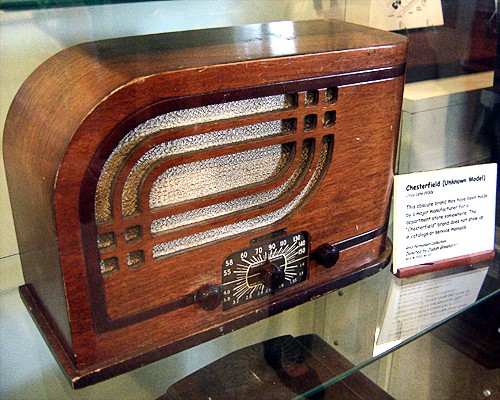The NBC Control Room in NYC, 1936
(photographer unknown)
Article by Bruce Berman
What did Russell Lee do when he was on the road? His notes indicate that he did a lot of thinking about what he had shot at the last stop and what he needed to shoot at the next stop. However, in the thousands of miles that he logged in for the Farm Security Administration (FSA) he must have found “blank spaces” in his travels, times when he was bored with the road, even the job and its mission.
Did he have a radio in his old Ford? He was an innovator and, as a photographer, he was up on the latest technology, being one of the first photojournalists of his day to use the Rollieflex Twin Lens Reflex (TLR) camera (which had a 2 1/4inch square negative and, thus, was small and mobile). This would lead one to speculate that, perhaps Lee was also interested in other technologies and, when he “hit the road” for the FSA, radios and radio networks were a fairly recent innovation.
There were 599 radio stations in 1936.
Broadcasting of the 599 broadcasting stations in the United States, approximately 500 were licensed to different individuals or corporations. There were two major network organizations–the National Broadcasting Company, operating two national networks linking in whole or part a total of about eighty stations, and the Columbia Broadcasting System, also linking about eighty stations but in a single network in whole or part. Most of these stations were individually owned by private enterprises.
News to people along Russell Lee’s Road, and other rural locations, could get there news more rapidly from radio than they could from print media and, once the radio had been purchased, the news was free if you were anywhere near a broadcasting tower or had a radio in your car.
Philco Model 600C, Original selling price:$25
The cost of a good desktop radio in 1936 was, on average, about $25.00. In 1936 that was the same buying power as $397.06 is in 2011.
Not cheap, but affordable, if you had a job or resources. Does this sound familiar?
When Motorola, which was the first radio for automobiles, went on sale in 1930, it cost about $110 uninstalled, at a time when you could buy a brand-new car for $650, and the country was sliding deeply into the Great Depression. A radio for a new car would cost about $3,000 today adjusting for 2011 dollars.
If you had an automobile and it came with a radio -most did not- you could listen to one of the broadcast networks tell you about the depression you were in but could not afford to listen to in a house you no longer owned. This would be like, today, trying to keep up with things on internet. If you had a computer you could always go find someone else’ WiFi.
You cannot take your desktop computer with you to a coffee shop to jump on the WiFi. But if you’re homeless, would you be able to resist selling your laptop for cash?
Russell Lee had a job in 1936, shooting images for the Historical Unit of the FSA which was part of the Works Progress Administration (W.P.A.). If you had a job, even a low paying one, you were “good.”
If you didn’t have a job -then as now- everything was increasingly beyond the consumer’s ability to have. Coming out of the abundance of the 1920’s, as it is coming out of the abundance of the Go-Go 1990s and early 2000s, these were hard -and technologically challenged- times.
Then as now, one could go from being a Have to being a Have Not, in one “Pink Slip” day.
Did radio equal the internet in 1936?
One could conclude that that is just one of the many parallels.
Did Russell Lee have a radio in his troublesome (it often broke down) Ford? Was he stopping to listen to President Rooseveldt and his Fireside Chats, did he listen to the crooner Bing Crosby as he tooled along U.S. 60? It is not clear. Did he listen to the country and western stations on the low watt stations in New Mexico and Texas?
One can only speculate on the type of music or news he heard, if he heard any at all (see the August 18, 2011 post on this web site).
When he got to Pie Town in 1937, he photographed people dancing and singing but all the music was produced by live musicians and there are no radios in any of his pictures from that town. He did photograph other pictures that are now in the Library of Congress that have an inclination to display how the times were getting better and people were, again, able to afford consumer products.
Whether these are government sponsored images/ideas or just an increasing ubiquity of radios is hard to know.1930’s PhotographyradioSmall Town America


